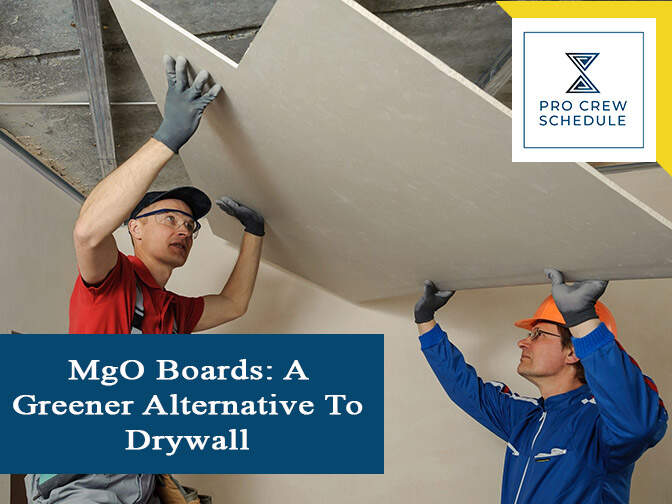Drywall has been the go-to construction material for decades– it can be used to construct ceilings and walls, and even several designs feature like arches and eaves. This material has been a staple in the industry because it is relatively durable and relatively easy to install and repair. Run by effective project management tools, many building projects that use drywall have succeeded. However, several disadvantages come with it, such as its susceptibility to water damage and recycling difficulty.
Modern innovations have once again solved a few of construction’s problems. Around the early 2000s, MgO boards, or Magnesium Oxide boards, have been getting attention in the industry. Many take advantage of its potential and have dubbed it “a greener alternative to drywall.”
What are MgO Boards?
MgO boards are construction panels that are made by combining magnesium and oxygen through heat and pressure to create MgO, or magnesium oxide. Once the heating process is done, the product shares the same characteristics as stone.
To turn them into panels, the stone-like material is crushed and ground into a fine powder. It is then mixed with water, perlite, chloride, sulfate or Epsom salts, and wood dust (cellulose), among other materials.
Uses of MgO Boards
MgO boards are similar to drywall in the sense that they can be used almost everywhere in constructing buildings. Specifically, they can be applied for houses as firewalls, wall panels, tile backers, ceiling boards in the interior, and sheathing, trim, siding, and fascia on the exterior.
Friendly to the environment
One of the most significant benefits of magnesium oxide boards is its positive impact on the environment. As previously mentioned, MgO boards do not contain chemicals like benzene, ammonia, and asbestos, which also have negative environmental effects.
Aside from the direct effects, MgO board production has additional long-term environmental benefits. First is its extended lifespan. Because of MgO boards’ incredible strength and resistance to several factors, buildings will tend to stand longer and thus won’t need significant repairs or renovations.
One other long-term effect MgO board manufacturing has is a reduced carbon footprint. It consumes only about 25% to 50% of the energy needed to produce calcium hydroxide or Portland cement. Additionally, the extreme green curing phase allows the material to capture CO2 carbon dioxide.
Magnesium oxide boards are recyclable and are also considered “nutritional waste.” This means that their lack of toxic substances does not compromise landfills or water sources. They can even be ground up and sprinkled into the soil as a nutrient.
Other Benefits of MgO Boards
1.Water-resistant
MgO boards hold up really well against water. Because it is impervious, these boards are still structural and dimensionally stable even when wet. Plus, they don’t swell, warp, or delaminate. They even protect against moisture when underneath basement flooring boards.
However, it is essential to note that MgO boards are moisture- and water-resistant, not waterproof. Although contact with water for short periods poses no major damage, being directly exposed to water for an extended amount of time can lead to hypothermal expansion. Generally, water exposure of more than one hour can damage the boards, magnesium board sellers would say.
Be that as it may, MgO boards are found to withstand salt damage in coastal areas. If they are installed outdoors, these boards must be coated or covered by another layer of materials.
2. Fire resistant
Magnesium oxide boards are a class A1 fire product and scored a 0 out of 0 on the (American Society for Testing and Materials) ASTM E84/UL 723 Flame Spread and Smoke Developed Index. This means that they are non-combustible and make no contribution to the spreading or growing of fire and smoke.
Plus, MgO boards are said to release about 30 lbs. of water vapor during fire incidents, helping in cooling and containing the fire.
3. Mildew and mold resistant
Because MgO boards are fully inorganic, it does not rot and mold, nor does it feed mildew. Moreover, the material scored a 0/0/0 rating on the ASTM G21, a standard antifungal test done on plastic products and polymeric materials to determine their fungal resistance.
4. Safe for people
People are safe from the health implications that naturally come with molds, mildew, and rotting because MgO boards are resistant to them, such as asthma, coughing, wheezing, throat irritation, eye irritation, nasal stuffiness, and even skin irritation.
Magnesium oxide boards do not off-gas and are generally made without any dangerous and toxic chemicals. Unlike other construction materials, MgO boards are free of asbestos, ammonia, silica, benzene, formaldehyde, which have their respective adverse side effects to health.
But both contractors and homeowners should still be careful when working with MgO boards. Masks and silica/concrete respirators must be worn when cutting and sanding so as not to inhale the dust particles. The best construction management software can aid in ensuring that the crew follows the safety protocols.
5. Can stand against termites and other insects
Aside from resisting mildew and mold, MgO boards’ inorganic property makes them strong against termites and other wood-boring insects, such as carpenter ants. They also contain zero foodstuff.
6. Easy to install
MgO boards are contractor-friendly for several reasons.
For one, it contains no carcinogenic dust, fly ash, and some other toxins, which makes it very safe to work with.
Another reason is that magnesium oxide boards are relatively quick and easy to install. These boards are 20% to 30% lighter than other cement-based boards, making them very lightweight and easy to transport. They can also achieve a beautiful Level 5 finish in half the amount of time and with half the resources it usually takes for other cement-like materials.
Although these boards easily and cleanly snap and score, cutting them with carbide saws and shaping with routers can produce even better results. When it comes to attachment, workers can do away with the usual time-consuming process and instead use a nail gun or self countersinking screws. Board installation would also be done more efficiently if supervised with a construction schedule software.
7. Works well with almost anything
Its excellent adhesion values make magnesium oxide boards highly versatile in terms of other materials it can work with. For finishes, any standard finish works on magnesium oxide boards, including:
● Concrete;
● Paint;
● Plaster;
● Stone;
● Tile;
● Brick
● Fabric;
● Wallpaper; and
● Synthetic stucco.
They even work well with structural panels and systems. MgO boards have adhesive properties that are great for Structural Insulate Panels (SIPS) and Exterior Insulated Finish Systems (EIFS) that make a wall’s insulation, moisture resistance, and fire rating better. Some companies are starting to include MgO boards in structural systems instead of selling them as individual panels.
8. Very durable
Compared to most, if not all, construction materials, magnesium boards come out superior in terms of strength and durability, specifically fastener holding, shear applications, and impact. To be specific, a 12 mm board, one #10 screw can support about 16 lbs. in tension and more than 200 lbs. in shear.
Since MgO boards are considerably hard, Corner and J beads are not necessary. Also, boards as thin as 10 mm can be used for walls and eight-millimeter boards work well enough for ceilings. A project management software can also substantially help in the better installment of these boards, as it can track both the project and the crew working.
MgO Boards vs. Other Materials
It’s safe to say that magnesium oxide boards have several advantages over other construction materials, based on the benefits previously mentioned.
a. Gypsum
Although both gypsum and magnesium oxide boards are eco-friendly, the former poses more harm to people because its fly ash releases toxins when cut.
b. Portland cement
Portland cement lacks water-resistant and fire-suppressing capabilities. Plus, MgO leaves a smaller carbon footprint compared to cement. And although Portland cement is recognizably strong, MgO has a higher rating on impact strength even though it is considerably lighter in weight.
c. Plywood
MgO is undoubtedly safer than plywood as a construction material. One, plywood is not flame-resistant and could quickly spread fire. Two, plywood is not water-resistant, making it susceptible to moisture that could grow mold and vulnerable to water damage.
d. Oriented strand board (OSB)
When it comes to safety, MgO ranks higher than OSB. The latter releases formaldehyde, a dangerous toxin. Plus, it is neither fire-resistant nor is it resistant to moisture and termites.
Drawbacks of MgO Boards
1. Initial cost
Compared to gypsum boards, magnesium oxide boards cost more but are close to cement boards.
As it usually is, the board’s quality will be dependent on the price, with cheaper once having lower quality, as experts suggest. But strength is not the only basis for quality. Other factors can include special installation requirements, temperature, and DIY instructions. Sometimes, when the project is done with general contracting, boards’ prices may vary, depending on what the contractor’s arrangements.
2. Sources
Even though magnesium oxide boards’ production leaves a good lasting impact on the environment, it’s transportation negates that. Many of the world’s natural deposits of magnesium oxide occur in China. Being a large source of this compound, China exports a lot of it overseas, leaving a significantly large carbon footprint. Although places like Europe and the US mine magnesium-based minerals, it is small and is unlikely profitable.







